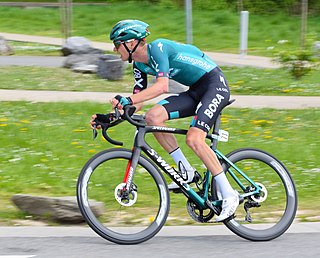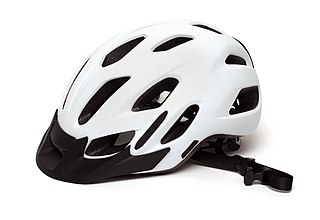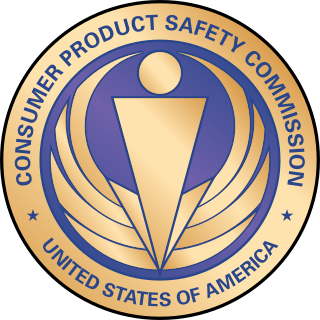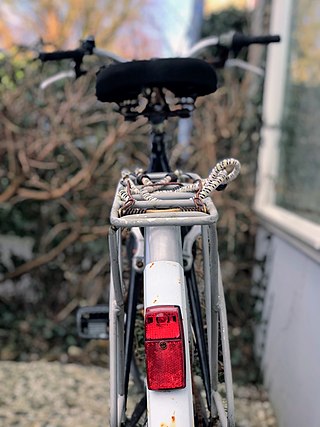
A motorcycle helmet is a type of helmet used by motorcycle riders. Motorcycle helmets contribute to motorcycle safety by protecting the rider's head in the event of an impact. They reduce the risk of head injury by 69% and the risk of death by 42%. Their use is required by law in many countries.

An all-terrain vehicle (ATV), also known as a light utility vehicle (LUV), a quad bike or quad, as defined by the American National Standards Institute (ANSI), is a vehicle that travels on low-pressure tires, has a seat that is straddled by the operator, and has handlebars. As the name implies, it is designed to handle a wider variety of terrain than most other vehicles. It is street-legal in some countries, but not in most states, territories and provinces of Australia, the United States, and Canada.

Road cycling is the most widespread form of cycling in which cyclists ride on paved roadways. It includes recreational, racing, commuting, and utility cycling. As users of the road, road cyclists are generally expected to obey the same laws as motorists, however there are certain exceptions. While there are many types of bicycles that are used on the roads such as BMX, recumbents, racing, touring and Utility bicycles, dedicated road bicycles have specific characteristics that make them ideal for the sport. Road bicycles have thinner tires, lighter frames with no suspension, and a set of drop handle bars to allow riders to get in a more aerodynamic position while cycling at higher speeds. On a flat road, an intermediate cyclist can average about 18 to 20 mph, while a professional rider can average up to 25 mph (40 km/h). At higher speeds, wind resistance becomes an important factor; aerodynamic road bikes have been developed over the years to ensure that as much as possible of the rider's energy is spent propelling the bike forward.

A bicycle helmet is a type of helmet designed to attenuate impacts to the head of a cyclist in collisions while minimizing side effects such as interference with peripheral vision.

The United States Consumer Product Safety Commission is an independent agency of the United States government. The CPSC seeks to promote the safety of consumer products by addressing "unreasonable risks" of injury ; developing uniform safety standards ; and conducting research into product-related illness and injury. In part due to its small size, the CPSC attempts to coordinate with outside parties—including companies and consumer advocates—to leverage resources and expertise to achieve outcomes that advance consumer safety. The agency was created in 1972 through the Consumer Product Safety Act. The agency reports to Congress and the President; it is not part of any other department or agency in the federal government. The CPSC has five commissioners, who are nominated by the president and confirmed by the Senate for staggered seven-year terms. Historically, the commission was often run by three commissioners or fewer. Since 2009, however, the agency has generally been led by five commissioners, one of whom serves as chairman. The commissioners set policy for the CPSC. The CPSC is headquartered in Bethesda, Maryland.

Bicycle lighting is illumination attached to bicycles whose purpose above all is, along with reflectors, to improve the visibility of the bicycle and its rider to other road users under circumstances of poor ambient illumination. A secondary purpose is to illuminate reflective materials such as cat's eyes and traffic signs. A third purpose may be to illuminate the roadway so that the rider can see the way ahead. Serving the latter purposes require much more luminous flux and thus more power.

John Forester was an English-American industrial engineer, specializing in bicycle transportation engineering. A cycling activist, he was known as "the father of vehicular cycling", for creating the Effective Cycling program of bicycle training along with its associated book of the same title, and for coining the phrase "the vehicular cycling principle" – "Cyclists fare best when they act and are treated as drivers of vehicles". His published works also included Bicycle Transportation: A Handbook for Cycling Transportation Engineers.

Bicycle safety is the use of road traffic safety practices to reduce risk associated with cycling. Risk can be defined as the number of incidents occurring for a given amount of cycling. Some of this subject matter is hotly debated: for example, which types of cycling environment or cycling infrastructure is safest for cyclists. The merits of obeying the traffic laws and using bicycle lighting at night are less controversial. Wearing a bicycle helmet may reduce the chance of head injury in the event of a crash.
Many countries have enacted electric vehicle laws to regulate the use of electric bicycles, also termed e-bikes. Some jurisdictions have regulations governing safety requirements and standards of manufacture. The members of the European Union and other regions have wider-ranging legislation covering use and safety.

The Snell Memorial Foundation is a nonprofit organization created to provide a high quality standard of safety for helmets. Founded in 1957, the foundation is named after William "Pete" Snell, a popular sports car racer who died in 1956 of head injuries he received when the racing helmet he wore failed to protect his head. A group of friends, scientists, physicians, and others joined together to create a group that would promote research and education as well as test and develop standards to improve the effectiveness of helmets.

The Consumer Safety Act (CPSA) was enacted on October 27th, 1972 by the United States Congress. The act should not be confused with an earlier Senate Joint Resolution 33 of November 20, 1967, which merely established a temporary National Commission on Product Safety (NCPS), and for only 90-days. Section 4 of the 1972 act established the United States Consumer Product Safety Commission (CPSC) as a permanent independent agency of the United States federal government and defined its basic authority. The act gives CPSC the power to develop safety standards and pursue recalls for products that present unreasonable or substantial risks of injury or death to consumers. It also allows CPSC to ban a product if there is no feasible alternative to an outright ban. CPSC has jurisdiction over more than 15,000 different consumer products. The CPSA excludes from jurisdiction those products that expressly lie in another federal agency's jurisdiction, for example food, drugs, cosmetics, medical devices, tobacco products, firearms and ammunition, motor vehicles, pesticides, aircraft, and boats. These products may fall under the purview of agencies such as the U.S. Food and Drug Administration, the U.S. Bureau of Alcohol, Tobacco, Firearms and Explosives, the U.S. Department of Agriculture, the U.S. Department of Transportation, the U.S. Environment Protection Agency, and the U.S. Federal Aviation Administration.

Toy safety is the practice of ensuring that toys, especially those made for children, are safe, usually through the application of set safety standards. In many countries, commercial toys must be able to pass safety tests in order to be sold. In the U.S., some toys must meet national standards, while other toys may not have to meet a defined safety standard. In countries where standards exist, they exist in order to prevent accidents, but there have still been some high-profile product recalls after such problems have occurred. The danger is often not due to faulty design; usage and chance both play a role in injury and death incidents as well.
Bicycle law in the United States is the law of the United States that regulates the use of bicycles. Although bicycle law is a relatively new specialty within the law, first appearing in the late 1980s, its roots date back to the 1880s and 1890s, when cyclists were using the courts to assert a legal right to use the roads. In 1895, George B. Clementson, an American attorney, wrote The Road Rights and Liabilities of Wheelmen, the first book on bicycle law, in which he discussed the seminal cases of the 1880s and 1890s, which were financed by Albert Pope of Columbia Bicycles, and through which cyclists gained the right to the road.
Motorcycling advocacy is activism for motorcyclists seeking to establish and protect their rights, and to influence issues of interest to the motorcycling community. This includes lobbying organizations that work to influence laws, and groups or individuals who influence public attitudes.
Bicycle helmets have been mandatory in New Zealand since January 1994. The statute, delineated in Part 11 of the Land Transport Rule 2004, states that "A person must not ride, or be carried on, a bicycle on a road unless the person is wearing a safety helmet of an approved standard that is securely fastened." The law describes six different acceptable helmet standards.
Cycling in Australia is a common form of transport, recreation and sport.

Next is an American bicycle brand distributed by Dynacraft BSC, Kent International Inc and Bridgeway International bicycle companies. Next bikes are produced in China and are sold in the American retail stores Wal-Mart.

Australia was the first country to make wearing bicycle helmets mandatory. The majority of early statistical data regarding the effectiveness of bicycle helmets originated from Australia. Their efficacy is still a matter of debate.

The wearing of bicycle helmets and attitudes towards their use vary around the world. The effects of compulsory use of helmets are disputed. Only the four countries of Argentina, Cyprus, Australia, and New Zealand currently both require and enforce universal use of helmets by cyclists. In some other jurisdictions partial rules apply, such as only for children, in certain states or sub-national divisions, or under other limited conditions.

Some countries and lower jurisdictions have enacted laws or regulations which require cyclists to wear a helmet in certain circumstances, typically when riding on the road or a road-related area. In some places this requirement applies only to children under a certain age, while in others it applies to cyclists of all ages.















